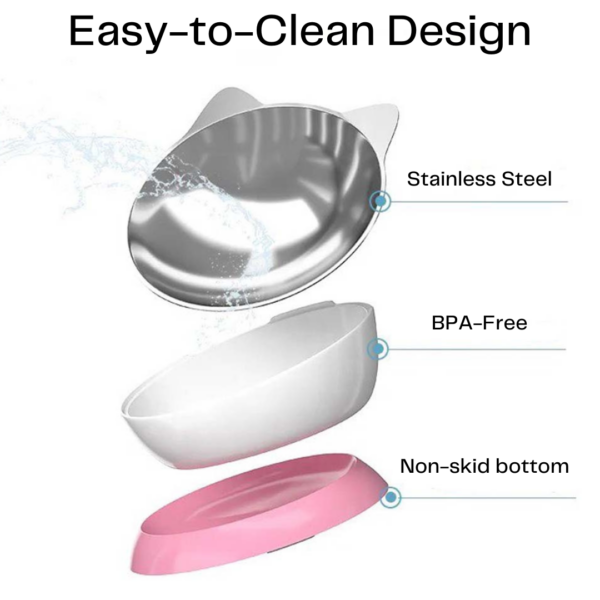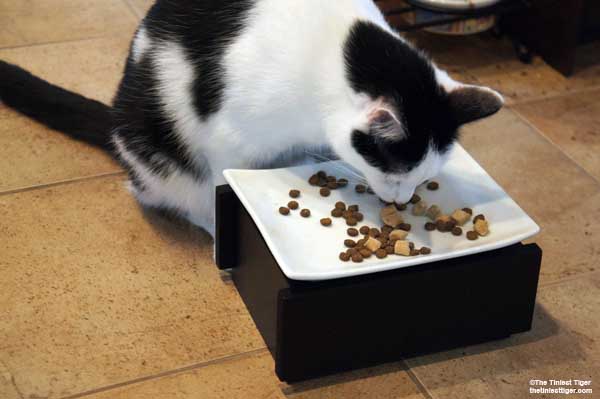
Best Material for Cat Bowls: Durable and Safe Choices for Your Feline
Choosing the right material for your cat’s bowl is more crucial than it might seem at first glance. The choice of material can impact not only the cleanliness of the feeding area but also your cat’s health. Common materials for cat bowls include plastic, stainless steel, ceramic, and glass, each with its own benefits and drawbacks. Plastic bowls are lightweight and inexpensive but can harbor bacteria and cause feline acne. Stainless steel and ceramic bowls are more durable and easier to clean, reducing the risk of bacterial contamination.
It’s essential to consider the design when selecting a cat bowl, as it can significantly affect your cat’s eating habits and comfort. Shallow bowls prevent whisker fatigue, while raised bowls can be beneficial for cats with arthritis. Moreover, some materials are better suited for specific features, such as non-slip bases or angled designs to improve accessibility. Maintenance is an important aspect to keep in mind, as ease of cleaning ensures a hygienic feeding space, with some materials being dishwasher safe, while others require hand washing.
Key Takeaways
- The material of a cat bowl affects health and hygiene.
- Bowl design influences a cat’s comfort during feeding.
- Maintenance considerations can dictate the best material choice.

Evaluating Cat Bowl Materials
Selecting the right material for a cat’s food and water bowls is critical as the material can affect both hygiene and the cat’s health.
Stainless Steel: Pros and Cons
Stainless steel cat bowls are acclaimed for their durability and rust-resistant properties, making them a long-lasting option. They’re typically considered food-grade and safe, and many models feature a non-slip bottom to prevent spills. One of the major advantages is that these bowls are dishwasher safe, ensuring easy cleanliness. However, they can be more expensive and less aesthetically varied than other materials.
Ceramic Choices for Cat PARENTs
Ceramic cat bowls offer a touch of elegance with their attractive designs and colors. High-quality ceramic bowls are often lead-free and microwave-safe, making them convenient for heating food. Despite their appealing appearance, ceramic bowls can chip or crack, which may harbor bacteria. Parents should opt for dishwasher-safe models to maintain hygiene.
The Risks and Benefits of Plastic Bowls
Plastic bowls are lightweight and generally inexpensive. Many are BPA-free and have the benefit of being dishwasher-safe. Certain types of plastic bowls may include a non-slip bottom feature. However, plastic can be prone to scratches that harbor bacteria, and in some cases, can cause chin acne in cats due to plastic sensitivity or allergies. Parents should be wary of phthalates in certain plastics, which can leach into food and water.

Design Features for Cat Comfort
Choosing the right cat bowl involves considering design features that directly affect a cat’s comfort during feeding. Design aspects such as whisker fatigue, bowl shape, and the height of the feeding station are essential for a stress-free and healthy eating experience.
Understanding Whisker Fatigue
Cats have highly sensitive whiskers which can become overstimulated when they repeatedly brush against the sides of a deep or narrow bowl. This condition is known as whisker fatigue. To prevent this, whisker-friendly bowls are designed to be shallow and wide, ensuring that whiskers do not touch the sides during eating.
The Importance of Bowl Shape
The shape of a cat bowl plays a significant role in mealtime comfort. A shallow bowl with high sides can contain food while still accommodating a cat’s natural eating posture. Wide and shallow bowls allow a cat to access food with ease, suggesting a unique design that caters to their physical form.
Elevated Bowls and Digestive Health
Positioning a cat bowl off the ground can aid a cat’s digestion and reduce digestive issues. An elevated cat bowl encourages a more natural eating stance, aligning the digestive tract and potentially minimizing the risk of regurgitation. Elevated platforms should be stable and at a suitable height that matches the cat’s shoulder level for optimal comfort.

Specialty Feeding Solutions
When selecting the best cat food bowls, it’s important to consider not just the material, but also specialized feeding solutions that cater to the specific needs of felines. These solutions aim to provide convenience, control portions, and ensure proper hydration.
Automatic Feeders and Convenience
Automatic feeders offer a convenient way to maintain a regular feeding schedule for cats. These devices can be programmed to dispense food at designated times, ensuring that cats have consistent access to their meals even when their guardians are away. Automatic cat feeders are ideal for pet parents who work long hours but want to ensure their cats don’t miss a meal.
- Convenience Features:
- Programmable meal times
- Secure food storage
Slow Feed Bowls for Controlled Portions
Slow feed cat bowls are specially designed to prevent cats from eating too quickly, which can aid in digestion and help manage portion sizes. These food bowls usually have raised patterns or obstructions that cats must navigate to reach their food, which also provides mental stimulation.
- Benefits:
- Promotes slow eating
- Helps prevent overeating
Water Fountains for Hydration
Water fountains for cats encourage them to drink more water due to the constant circulation of water which keeps it fresh. The best cat bowls for water often include features like triple filtration to remove impurities and keep water clean, which is crucial for cats’ kidney health and overall well-being.
- Features:
- Moving water attracts cats
- Filters enhance water purity
Cleaning and Maintenance

The choice of material for a cat’s bowl greatly impacts the ease of cleaning and maintenance. Stainless steel bowls are renowned for their durability and ease of cleaning. They are typically dishwasher safe, which ensures that they can be easily sanitized. Parents should regularly clean these bowls to prevent the build-up of bacteria, which could cause health issues for the cat.
Ceramic bowls, another popular option, also boast dishwasher safety. However, they require careful handling to avoid chips and cracks where bacteria can thrive. To maintain their integrity, these should be inspected regularly for damage and replaced if necessary.
Plastic bowls are often lightweight and affordable, but they may not be as easy to keep clean. Scratches in the plastic can harbor pathogens; thus, these bowls should be checked frequently and replaced when they show signs of wear.
A silicone mat can serve as a hygienic and easy-to-clean base, especially when used beneath bowls to catch spills. A silicone mat can be easily wiped down or placed in the dishwasher, which contributes to a cleaner feeding area.
Here is a breakdown of common materials:
| Material | Dishwasher Safe | Considerations |
|---|---|---|
| Stainless Steel | Yes | Durable, regular cleaning recommended |
| Ceramic | Yes | Handle cautiously to avoid chips, replace if damaged |
| Plastic | Varies | Replace if scratched; not as durable as other options |
Additional Considerations
When selecting the best material for cat bowls, it is essential to consider not just the material’s durability or ease of cleaning but also how it impacts safety, suitability for individual cats, and the bowl’s integration with home aesthetics.
Safety and Health Concerns
Safety is paramount when choosing a cat bowl. Materials should be food-grade, BPA-free, and lead-free to prevent any potential health risks. Additionally, cat parents should look for bowls with a rubber or non-slip base to minimize spills and movement while the cat is eating.
Aesthetics and Home Decor
Guardians who value attractive designs will find a range of options to complement home decor. Bowls with unique designs can serve as a point of interest in a room. The chosen material, whether it be ceramic with a glossy finish or brushed metal, should match the overall style and color scheme of the household while maintaining the primary focus on the cat’s needs.
Innovative and Unique Bowl Options
When selecting the best material for cat bowls, the market offers innovative choices that merge functionality with unique design.
The market also includes bowls with plant-based materials, aimed at eco-conscious pet parents. These materials can be sustainable and offer a unique touch to a pet’s dining area. Bowls utilizing bamboo fibers, for instance, offer a modern twist on traditional designs.
Here’s a quick comparison:
| Material | Design Feature | Benefit |
|---|---|---|
| Stainless Steel | Removable Rubber Base | Reduces Noise and Slippage |
| Bamboo Fiber | Eco-Friendly Material | Sustainable and Stylish |
| Plastic | Whisker-Friendly Shape | Prevents Whisker Fatigue |
Pet parents who value both form and function will find that innovative bowl options provide their feline friends with not just a meal station, but an accessory that fits into the aesthetic of a modern pet-friendly home. Each material brings its own set of advantages, whether prioritizing durability, design, or sustainability.

Frequently Asked Questions
When selecting the best material for cat bowls, pet parents must consider various factors, including the material’s benefits, health implications, and the specific needs of their feline companions.
What are the advantages of stainless steel cat bowls compared to other materials?
Stainless steel cat bowls offer durability, are simple to clean, and do not harbor bacteria easily. They do not break if dropped and are typically dishwasher-safe, making them a hygienic option for feeding cats.
How does whisker fatigue affect a cat’s eating habits, and which bowls are best to alleviate it?
Whisker fatigue can make eating a stressful experience for cats, as their sensitive whiskers touch the sides of a bowl while eating. Shallow, wide bowls reduce the chances of whisker fatigue, allowing cats to eat comfortably without overstimulating their whiskers.
What should I consider for the health of my cat when selecting a material for cat food bowls?
The chosen material for cat bowls should be non-porous to prevent bacterial growth and be free from harmful chemicals. Non-reactive materials like stainless steel and high-quality ceramic or tempered glass are considered safe options.
Are ceramic bowls suitable for both dry and wet cat food?
Ceramic bowls, when properly glazed and maintained, suit both dry and wet cat food. They are heavy, reducing the likelihood of tipping, and should be free from lead and other harmful glazes to ensure they are safe for use.
Which type of bowls is recommended for cats to ensure proper hydration?
Bowls made of ceramic or stainless steel are recommended for water as they keep the water cooler for longer periods. Additionally, some cats prefer running water, and thus, pet fountains made from these materials may encourage better hydration.
Is it better for cats to eat from elevated bowls, and what materials are most suitable?
Elevated bowls can aid in digestion and are often more comfortable for cats, especially those with arthritis. Stainless steel bowls in a raised stand provide both durability and the benefits of elevation.